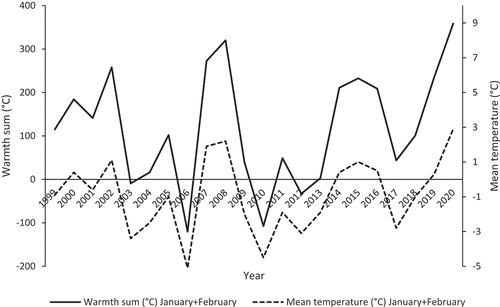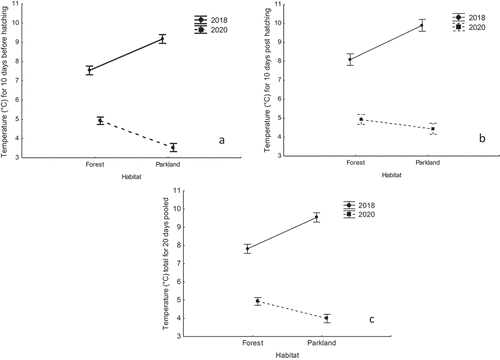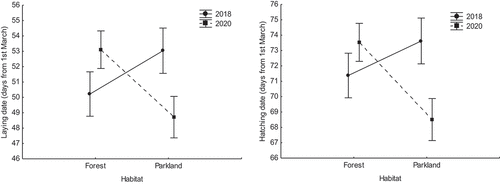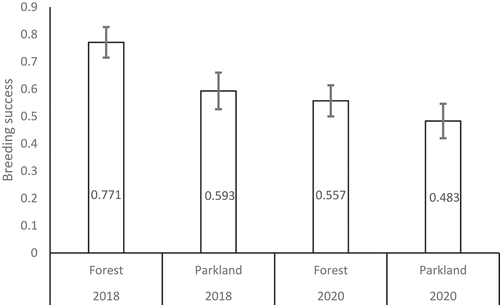Figures & data
Table I. Summary of pre-breeding and breeding period weather conditions: mean temperature (°C) for January and February (2018 and 2020) for the urban parkland (Lublinek) and the forest study area (Dobra-Nowiny), the warmth sum (°C) for January and February (the sum of the daily maximum temperatures during the period) for 2018 and 2020 for both study areas, the sum of precipitation (mm) for March and April (2018 and 2020) for both study areas, and the mean temperature and the warmth sum for May for 2018 and 2020 for both study areas.
Figure 1. Mean temperatures (°C) of January and February (1999–2020) and the warmth sum (°C) for January and February (the sum of the daily maximum temperatures during the period) for the period 1999–2020, based on the data from the Lublinek meteorological Station.

Table II. Summary of three separate general linear models examining differences in the brood-adjusted minimum temperature (°C) for 10 days before hatching (incubation), 10 days from hatching and total of 20 days pooled between both study sites and years – 2018 vs. 2020 (significant p-values in the model are in bold). Each model included a particular adjusted temperature indicator as the response variable assuming Gaussian error structure in relation to year and site factors and their interaction.
Figure 2. Minimum values of individual great tit brood adjusted temperature (°C) for 10 days before hatching (A), for 10 days after hatching (B) and total for 20 days pooled (C) in the forest and in the urban parkland study areas - 2018 vs. 2020 (data shown as mean ± SE).

Table III. Summary of two separate general linear models examining differences in the mean laying dates (days from 1 March) and mean hatching dates between both study sites and years – 2018 vs. 2020 (significant p-values in the model are in bold). In both cases, the date was modelled as the response variable (Gaussian error structure) in relation to year and site factors and their interaction.
Table IV. Summary of two general linear models examining differences in clutch size and the number of fledglings between both study sites and years – 2018 vs. 2020 (significant p-values in the model are in bold). In both cases, the response variable (clutch size or the number of fledglings) was modelled assuming Gaussian error structure in relation to year and site factors and their interaction.
Figure 3. Mean laying and hatching dates (days from 1 March) in the forest and in the urban parkland study areas – 2018 vs. 2020 (data shown as mean ± SE).

Figure 4. Mean clutch size and number of fledglings in the forest and in the urban parkland study areas - 2018 vs. 2020 (data shown as mean ± SE).

Figure 5. Breeding success (proportion of fledglings produced per egg laid) in the forest and in the urban parkland study areas - 2018 vs. 2020 (data shown as mean ± SE).

Table V. Summary of the generalized linear model of breeding success (the number of fledglings in relation to clutch size, assuming binomial error structure) of great tits in relation to year (2018 vs. 2020) and site (urban park vs. forest) as factors and in relation to the year-centered date of hatching (hatch date) as a covariate. The logit link function was applied, so that breeding success was expressed as natural log of the odds of hatched eggs to unhatched egg. The main model included the response variable in relation to year and site factors and the date of hatching (quantitative variable), and their interactions.
